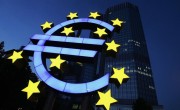This is a Guest Post by Simon Smith, Head of Research at FxPRO. Simon has over seventeen years experience of macro forecasting and investment strategy research. Prior to joining FxPro in May 2010, Simon was a consultant with Thomson Reuters, having spent four years as Chief Economist at Weavering Capital.
He has held economic and strategy positions with Standard & Poor’s, together with consultancy firms 4Cast and MMS International. Simon holds an MSc. in Economics from the University of London and a BSc. from Brunel University. 
……………………………………………….
The twenty four hours since the ECB rate decision have been remarkable, not least for the volatility we’ve seen in FX markets, EUR/USD trading a near three-cent range and ending the period pretty much where it started. The simple question to be asked, was this a game changer?
The answer is broadly yes but, as always, it is never quite that clear cut. Like all central banks, the ECB is in territory it is not comfortably inhabiting, buying bonds of troubled peripheral nations (known as the Securities Markets Program) being one of the issues. The trouble was that, with the ECB assuming preferred-creditor status (so it would be paid first in any subsequent default or restructuring), its ability to bring down funding costs was becoming constrained by the fear of remaining bond-holders that they were at increased risk of being disadvantaged in the future.
It’s notable that it was only in an answer to a question did the ECB state that in the future it would buy bonds only at the shorter end of the curve (so nearer to 2yr than 10yr) and also provide details of the countries and amounts purchased, because this is the factor that has proven to be most positive for markets.
What’s also remarkable is that there is still some confusion over whether the ECB is going to undertake unsterilised bond purchases. In other words, undertake quantitative easing in the same way as the UK or US central banks. Our interpretation leads us to think they won’t, so they will continue to ‘mop-up’ the extra liquidity created by bond purchases on a weekly basis.
But what matters for FX is how these and the other measures will impact the bond markets. FX rates tend to be better correlated to short-term interest rate differentials (so up to 2yr ) rather than the longer-term ones (10yr and beyond). Of course, for the eurozone, there’s no single 10yr government interest rate. But this observation still holds true if we use euro swap rates (money market rates) instead of bond yields. In contrast, if we look at the relationship between peripheral bond yields (taking an average of the main five) for both 2yr and 10yr maturities, the latter is the one that is more strongly correlated to moves in FX.
So for FX, the main issue is how quickly the ECB can start with SMP2, and whether the push lower in short-dated yields it is expected to bring about will spill down the yield curve and push 10yr yields lower as well. If past correlations hold, then this should be supportive for the single currency. In the process though, should the ECB take on the credit risk (so it stands equal in the queue with private sector investors in the credit hierarchy), then it could be looking less like a central bank and more like a hedge fund. This is one of several reasons why Germany is not on board.
Read More:
Tradersdna is a leading digital and social media platform for traders and investors. Tradersdna offers premiere resources for trading and investing education, digital resources for personal finance, market analysis and free trading guides. More about TradersDNA Features: What Does It Take to Become an Aggressive Trader? | Everything You Need to Know About White Label Trading Software | Advantages of Automated Forex Trading









